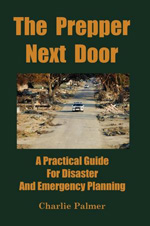I watched a curious video from Bushcraft412, an outdoor survival guy. He says many of us (preppers) aren’t prepared despite having tons of stuff stocked up. He says many preppers are rigid, trying to hold on to our lifestyle. He says flexibility is key. He promotes primitive living. He asks: What happens when our supplies run out?
As a moderate prepper, after three to six months, I fully expect that things will return to “normal” after most disasters. I don’t believe society will revert to a primitive state for a long period of time. Supplies can usually carry you through. He has a valid point though: it’s good to learn new skills. We aren’t going to head for the hills and live off the land for an extended period of time after most disasters.
***
Hurricane Sandy was rare in that it was a November hurricane. It was followed up by cold weather and snow. Preppers in northern states should give some thought to heating their home during an emergency. There are many options. For those in the country who rely on heating oil, you’re basically all set.
One issue with storing hundreds of gallons of heating oil is the danger of a leak. Here is a nice pdf about minimizing that risk.
You can find an array of heating options on Northern Tool. One that looked interesting (but too expensive!) was a pellet stove that fit in a window, like an window air conditioner. It would let you heat a small room. I bet a lot of heat is wasted with such a unit, and I’d worry about fire issues, but on the upside, it draws its combustion air from the outside, which is a nice safety feature. The unit has a blower, so you’d need to be able to generate some electricity.
For the ultra-low-budget do-it-yourselfer, Northern has a door, legs, and piping to let you make a wood-burning barrel stove. Safely rigging up this stove in an emergency would be the big issue.
Between the $1,400 window pellet stove and the $40 stove kit, Northern has other stoves and heaters to give you ideas for providing heat during disasters. You can be a rich prepper or a poor prepper, but you shouldn’t be a cold prepper.
***
Like many urban preppers, I have little use for diesel fuel in my daily life. Diesel fuel has much in common with heating oil, although they’re not usually the same. For preppers who want to store substantial fuel for a generator, diesel is one option. It keeps a long time. It’s less flammable than gas. Here is a video comparing the flammability of diesel to gasoline.
***
This article (twincities.com) addresses the sanitation issues that arose after Hurricane Sandy. With no working restrooms, kids are peeing on walls, with their parents’ approval. One father joked, “They’re turning feral.”
***
In Minnesota, a 64-year-old fellow had repeated trouble with teenage prowlers seeking drug money breaking into his home. He shot two of them and is now facing murder charges. When his Mini-14 jammed, he used his handgun.
http://www.startribune.com/local/180853761.html
http://www.startribune.com/local/180853921.html (this story was deleted the next day)
It’s a sad story. I feel bad for both sides. The teenagers shouldn’t have broken into his home or tormented him. If you must defend your life, it’s important to be prepared for events that occur after the shooting. Most serious defense courses teach this.
Many of us have been taught to shoot and keep shooting until an attacker is down, but realistically, firing six or seven shots into an attacker can put us in legal peril. It looks like we’re being needlessly aggressive. This is one advantage to a shotgun, one blast is usually effective. Once an attacker is down and no longer a threat, stop shooting.
Another thing: Call the police and an ambulance immediately. This event happened on Thanksgiving and the guy didn’t want to bother the police on a holiday. He contacted them the next day. He might have been in shock, but as a rule, don’t let bodies lie around the house for days. That creates suspicion.
Final basic point: Don’t move bodies. Authorities don’t like that. It’s probably best to immediately contact an attorney if you think you might need one and have them present during questioning. If at all possible, you never want to fire on somebody if you can avoid doing so to avoid possible legal problems.
***
nuclearvault on Youtube has over 1,000 military and police videos. Some of the interesting ones:
An old LA police video about restraining suspects: “a kick to the back of the knee will increase his cooperation by about 100%”:
http://www.youtube.com/watch?v=JsEu02D175c
–
U.S. Rifle, Cal. 7.62MM M-14 Operation And Cycle Of Functioning (1960). This video has a really nice (nearly 30 minute) discussion about the operation of the M1A type rifles. It explains the basic operation of gas-operated semi-automatic rifles really well. (8:41 is the start of explanation of how gas operation works). It goes over how selective fire on the M-14 works, at a basic mechanical level. As most preppers know, the M-14 is the select fire version of the Springfield M1A.
http://www.youtube.com/watch?v=gGyCEdGd_D0
The M-16 rifle:
http://www.youtube.com/watch?v=bJODc5t7SGY
–
This video comes from a guy (alaskabearhawk) who’s building his own airplane! An ambitious project for those interested in knifemaking is his five-part video about how he built his own 2 x 72-76″ belt grinder. These things usually cost upwards of $500, so building your own can save some coin.
http://www.youtube.com/watch?v=5ONrJB5sDQk
***
Bodybuilder Scooby has a Youtube video about staying fit and healthy after age 50. He makes an important point: We must keep our brain fit by learning new things. If you want to keep your brain at its best, consider taking up dance. This article (stanford.edu) discusses the benefits of dancing.
Well, home heating oil to M-14s to feral kids to dance. That’s about it for today’s post.
